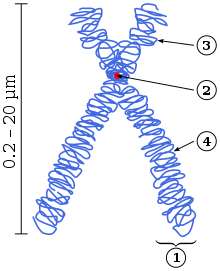Chromatid
one of the two daughter strands of a duplicated chromosome that become apparent between early prophase and metaphase in mitosis and between diplotene and second metaphase in meiosis
Chromatids are the daughter strands of a duplicated chromosome which are joined by a single centromere. When the centromere divides, the chromatids become separate chromosomes.[1]

(1) Chromatid – one of the two parts of the chromosome after duplication.
(2) Centromere – the point where the two chromatids touch.
(3) Short arm. (4) Long arm.
Each of the two daughter chromatids contains the same DNA and chromatin protein as its original chromosome. But in meiosis, crossing over (exchanges) take place between two of the non-sister chromatids. This has profound consequences: it produces genetic recombination, and increases the variability of gametes.
Reference
change- ↑ King R.C. Stansfield W.D. & Mulligan P.K. 2006. A dictionary of genetics, 7th ed. Oxford. p79